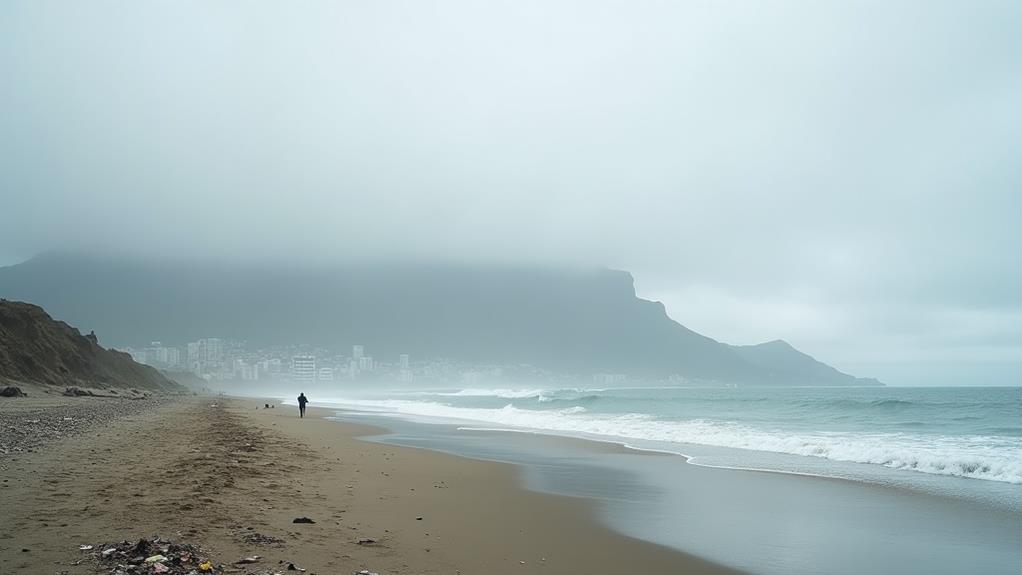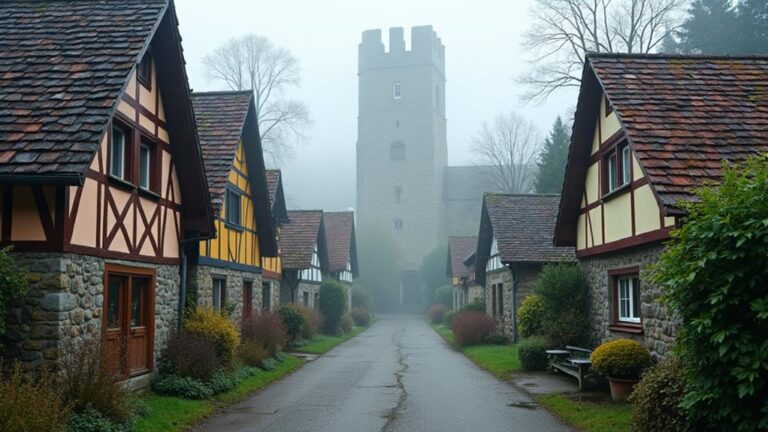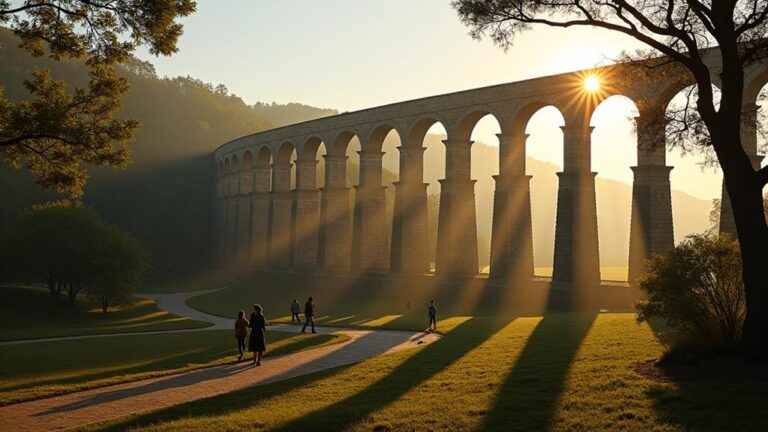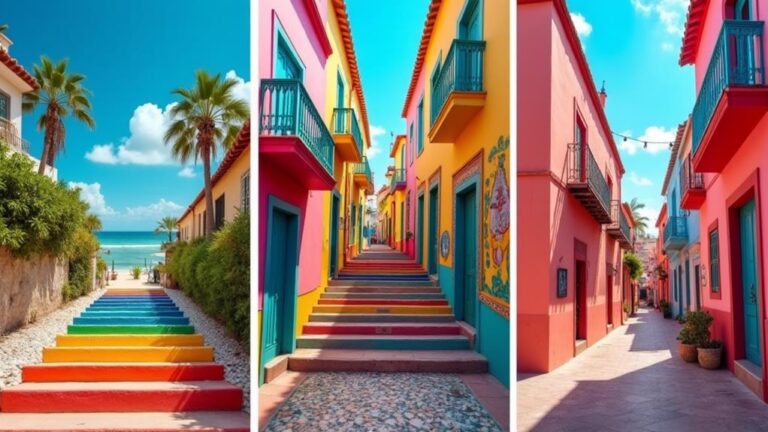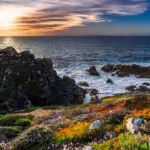You seek sunshine, scenery, and unforgettable experiences in South Africa, but you also want to avoid the chaos that comes with peak season. You're looking for the perfect balance between pleasant weather and manageable crowds, but unfortunately, there's a time of year when the crowds are overwhelming and the prices are steep. The peak summer months of December to February seem like an ideal time to visit, but they're actually the worst. As you consider planning your trip, you might want to know why these months are best avoided – and what alternatives you have for a smoother, more enjoyable experience.
Contents
Key Takeaways
- Peak tourist season (Dec-Feb) is the worst time due to overcrowding and high accommodation prices.
- June and July mid-year school holidays are busy, especially in national parks and game reserves.
- Winter rainfall and storms (June-Aug) can limit tourist activities, especially in coastal regions.
- Heatwaves during peak summer months can make the heat unbearable, especially in inland areas.
- Long queue waits can be expected at popular attractions and airports during peak tourist season.
Peak Summer Months
When it comes to visiting South Africa, timing is everything, and the peak summer months, which occur from December to February, are a great time to soak up the country's warm weather and vibrant culture.
You'll get to experience the quintessential summer vibes, with long days filled with sunshine and balmy nights perfect for outdoor gatherings.
However, be prepared for the heat waves that can sweep across the country during this time.
The temperatures can soar, especially in the northern regions, reaching as high as 40°C (104°F) in some areas.
Coastal regions tend to be cooler, but the humidity can make the heat feel more intense.
If you're not comfortable with extreme heat, you might want to consider visiting during the shoulder season.
On the other hand, if you enjoy the sun and are looking for a warm winter getaway, the peak summer months could be the perfect time for you to visit South Africa.
Just be sure to pack accordingly, with light, breathable clothing and plenty of sunscreen to protect yourself from the sun.
Mid-Year School Holidays
Mid-year school holidays in South Africa typically take place in June and July, making these months a great time to plan a family vacation.
However, you'll need to be prepared for the crowds that come with it. As a popular time for family vacations, national parks and game reserves can get quite busy.
If you're planning to go camping, expect crowded campsites, especially during weekends and school holidays. This might make it difficult to get a booking at some of the more popular campsites, so it's essential to plan ahead.
You'll also need to be prepared for higher prices for accommodations and tour packages. Many tour operators and lodges offer special family packages during this time, which can be a great option if you're traveling with kids.
Just make sure to book well in advance to avoid disappointment. If you're looking for a more relaxed vacation, you might want to consider visiting during the shoulder season instead.
However, if you're traveling with kids, mid-year school holidays can be a great time to visit South Africa, with many activities and attractions geared towards families.
Low Season in Winter
As you plan your trip to South Africa, keep in mind that winter, from June to August, is considered the low season.
You'll want to pack warm clothing for chilly morning temperatures, especially in the southern and western regions.
Winter's also a time of rainfall and storms in some areas, which may limit certain tourist activities.
Chilly Morning Temperatures
During the low season in winter, South Africa's mornings can be deceptively chilly, especially in the higher-lying areas and along the coast.
You'll notice the temperature difference as you step out into the crisp airways that greet you as the sun rises. Frosty winds can make the chill feel even more biting, so it's essential to pack warm clothing for your trip.
If you're planning to visit popular destinations like Johannesburg, the Drakensberg Mountains, or the Garden Route, be prepared for icy mornings.
Temperatures can drop significantly overnight, and the chill can linger well into the morning. You might even notice a bit of frost on the grass or cars in some areas.
While the chill might be uncomfortable, it's also a great excuse to enjoy some of South Africa's best winter activities, like hiking or horseback riding in the beautiful winter landscapes.
Just be sure to dress warmly and bring a hat and gloves to keep you cozy. As the day wears on, the sun will warm things up, and you'll be able to enjoy the beautiful scenery without the chill.
Rainfall and Storms
Winter rainfall in South Africa is a defining feature of the low season.
If you're planning to visit during this time, you'll likely experience heavy rainfall and stormy weather. June to August is the wettest period, with the Western Cape region receiving the most significant amount of rain.
The rain can be intense, leading to flash floods and disruptions to outdoor activities.
Some things to keep in mind when visiting South Africa during the low season include:
- Heavy rainfall can cause road closures, making it difficult to travel between destinations.
- Stormy weather can bring strong winds, rough seas, and large waves, making coastal activities hazardous.
- The rain can also make some outdoor activities, such as hiking and game drives, challenging and uncomfortable.
When planning your trip, it's essential to check the weather forecast regularly and be prepared for any eventuality.
Pack accordingly, bringing waterproof gear and clothing that can withstand the rain and wind.
Additionally, consider visiting indoor attractions, such as museums and shopping centers, to minimize the impact of the rain on your trip.
Limited Tourist Activities
A tourist's playground, South Africa's winter season can be a challenging time for outdoor enthusiasts.
If you're planning to visit during this time, you'll find that the low season affects not just the weather, but also the activities you can enjoy. Many popular attractions and tourist spots operate on limited hours, which can put a damper on your travel plans.
You might find that some attractions are closed altogether, forcing you to adjust your itinerary.
For instance, many hiking trails and outdoor sites may be closed due to strong winds, heavy rainfall, or maintenance. Even some popular museums and historical sites might reduce their operating hours or close temporarily.
This means you'll have to plan your days carefully to make the most of your trip. It's essential to check the attraction's website or contact them directly to confirm their hours before heading out.
Rainy Season in East Coast
Exploring South Africa's East Coast, you'll likely encounter a rainy season that's both a blessing and a curse for travelers.
On one hand, the rain brings life to the region's lush landscapes, making it a great time for nature lovers and outdoor enthusiasts.
On the other hand, it can put a damper on your beach plans and make the humid climate feel unbearable.
If you're planning to visit the East Coast during the rainy season, here are a few things to keep in mind:
- The rain can make the roads slippery and increase the risk of accidents, so be cautious when driving.
- Some tourist attractions and activities might be closed or limited due to the weather.
- The East coast beaches can be affected by strong winds and rough seas, making them less ideal for swimming and sunbathing.
Despite the challenges, the rainy season can be a great time to explore the East Coast's cities, such as Durban and Port Elizabeth, which offer a rich cultural and historical experience.
Just be prepared for the humid climate and potential rain showers.
With the right mindset and planning, you can still have a great time exploring this beautiful region.
Peak Tourist Season Chaos
You're probably aware that peak tourist season in South Africa is a magnet for travelers from around the world, but are you prepared for the chaos that comes with it?
As you plan your trip, you'll need to consider the crowds that flock to popular attractions, the skyrocketing prices of accommodations, and the long wait times that come with them.
If you're looking to make the most of your trip, it's essential to know what to expect and plan accordingly during this busy period.
Overcrowded Popular Attractions
Navigating South Africa's popular attractions during peak tourist season can be overwhelming, especially when dealing with massive crowds.
If you're not fond of crowded markets and long lines, visiting during peak season mightn't be the best idea. You'll likely experience tourist fatigue, feeling exhausted from the hustle and bustle of popular spots.
Some popular attractions to expect massive crowds at include:
- Table Mountain, where you might've to wait in line for hours to ride the cable car to the top
- Robben Island, where the ferry ride and tours can get congested
- Boulders Beach, where the famous penguin colony can get swarmed with visitors
You'll also find that popular shopping districts and markets, like the Neighbourgoods Market in Cape Town or the Rosebank Art & Craft Market in Johannesburg, can get packed with tourists and locals alike.
This can make for a stressful and overwhelming experience, especially if you're looking for a more relaxed vibe.
Considering visiting during the shoulder season might be a better option if you want to avoid the chaos.
High Accommodation Prices
South Africa's peak tourist season doesn't just bring massive crowds to popular attractions – it also drives accommodation prices through the roof.
If you're planning to visit during this time, be prepared for a hefty dent in your wallet. Prices for hotels, lodges, and even guesthouses skyrocket, making it challenging for travelers with budget constraints. You might find yourself shelling out double or triple the usual rate for a place to stay.
If you're determined to visit during peak season, it's essential to book your accommodation well in advance to avoid last-minute rate hikes.
However, if you're flexible with your travel dates, consider visiting during the shoulder season when prices are more reasonable. Keep an eye out for last-minute deals, which can sometimes offer discounts on unsold rooms.
But be cautious – these deals often come with conditions, and you mightn't get the best room or services. With some planning and flexibility, you can still find affordable accommodation options in South Africa, even during the peak tourist season.
Long Queue Waits
Frequently, the peak tourist season in South Africa brings with it massive crowds that aren't just a nuisance, but also a significant source of frustration – especially when it comes to waiting in long queues.
You'll likely find yourself stuck in a seemingly endless line at the airport, waiting to check in, drop off your bags, or go through security.
This airport congestion can be overwhelming, to say the least.
- You might spend hours waiting in line at OR Tambo International Airport in Johannesburg, one of the country's busiest airports.
- Border delays are also common during peak season, especially if you're driving or taking a bus from neighboring countries like Mozambique or Namibia.
- To make matters worse, long queues can also be expected at popular tourist attractions, such as the Cape of Good Hope or Table Mountain.
To minimize your waiting time, consider arriving at the airport early, checking in online, and choosing a less busy time to visit popular attractions.
While these tips can help, they mightn't completely eliminate the frustration of waiting in long queues.
Extreme Weather Conditions
One thing to keep in mind when planning a trip to South Africa is that the country's diverse geography can lead to extreme weather conditions.
You'll find that the climate varies greatly from the coastal regions to the inland areas, making it essential to research and prepare for the specific region you plan to visit.
In the summer months, heatwaves are a common occurrence, especially in the northern parts of the country.
Temperatures can soar above 40°C, making it challenging for tourists to explore the outdoors.
It's crucial to stay hydrated and take breaks in shaded areas to avoid heat exhaustion.
Dust storms are another extreme weather condition you might encounter in South Africa, particularly in the dry and arid regions.
These storms can reduce visibility and cause respiratory problems.
If you're planning to visit during the dry season, consider packing a mask to protect yourself from the dust particles.
Conclusion
You've probably heard that the peak tourist season is the worst time to visit South Africa, but is that really true? If you're looking for a stress-free trip, the answer is yes. Overcrowding, high prices, and scorching heat waves make December to February a less-than-ideal time to visit. Add to that the mid-year school holidays and winter rainfall, and you've got a recipe for chaos. So, plan ahead and avoid the peak season for a more enjoyable trip.

